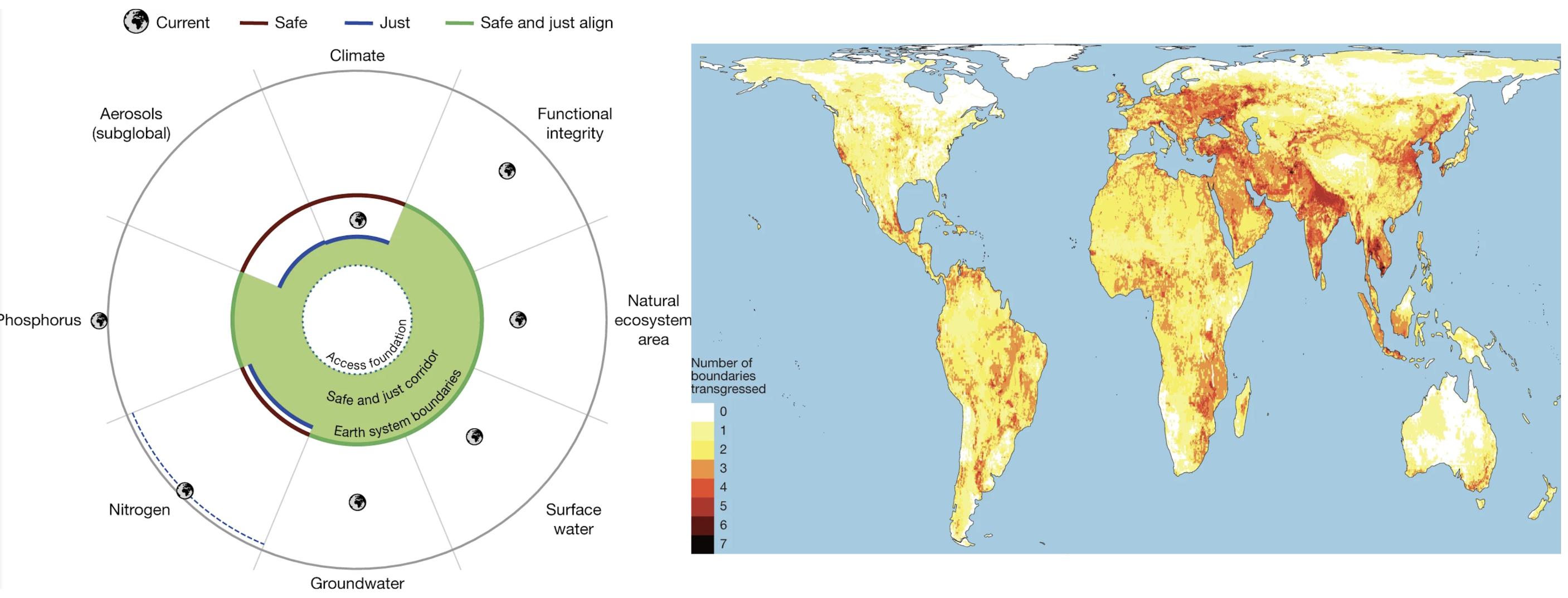Environmental and social scientists recently released a follow-up to the planetary boundary framework called the safe and just Earth system boundaries. As the authors state to open the article, “the stability and resilience of the Earth system and human well-being are inseparably linked.”
The analysis provides a modern scientific underpinning to many global philosophies that Indigenous thought leader Robin Wall Kemerer simply summarizes with this thought: “All flourishing is mutual.”
The original planetary boundary framework, first published in 2009 and updated in 2015, focused on understanding the vital biophysical systems — climate, water, nutrients, biodiversity and aerosols — that support human life on Earth. It quantified the limits of these systems within which human life can be sustained, which equates to “safe” boundaries.
The scientists have added three justice lenses to this year’s update to the framework: interspecies (between humans and other species), intergenerational (between past, current and future generations) and intragenerational (between different countries, communities and people in the current generation) justice. The concept of “just” boundaries refers to the level of change each system can withstand before significant harm is done to humans.
By adding these justice criteria, the scientists could assess whether staying within physically safe boundaries will be enough to prevent people from significant harm across time (intergenerational justice) and space (intragenerational justice).
The analysis finds that we’ve crossed two or more safe and just Earth system boundaries for 86 percent of the population and four or more boundaries in regions where more than a quarter of the Earth’s population lives. The areas most affected are where the greatest efforts will be needed to get back in harmony with the environment and each other.

The food system’s role in reaching this point
The assessment gives a snapshot of the planet’s degradation since the Industrial Revolution and how this affects non-human species, various communities and successive generations differently. It doesn’t delve deeply into the causes pushing us past the boundaries nor does it provide prescriptive solutions.
However, while reading through the findings, I could easily see the role of current agriculture and food system practices in driving negative impacts across the interconnected earth systems.
Here are some illuminating data points that link food and agriculture practices to the Earth’s current state for the five biophysical systems.
- Climate: Food and agriculture activities account for up to 37 percent of global greenhouse gas emissions.
- Biosphere: Agriculture is responsible for 86 percent of species at risk of extinction.
- Water: Agriculture accounts for 70 percent of freshwater withdrawals.
- Nutrients: Over 80 percent of inorganic phosphorus is lost from “mine to fork” and less than 2 percent of the nutrients that make up cities’ food supplies are recovered and put to productive use.
- Aerosols: Fumes from excess nitrogen fertilizers and animal waste combine with combustion emissions in the air to form the largest share of aerosol pollution.
Building justice into the agrifood business
There’s a saying in the world of building intersectional progress that change happens at the speed of trust. Food and agriculture companies must integrate a justice lens into sustainability strategies to create this trust.
So let’s look at how companies can incorporate justice into their business models.
- Intergenerational justice: Take responsibility for and address the negative historical impacts of your business model. Listen to and partner with youth across your key stakeholder groups, including suppliers, employees and customers.
- Intragenerational justice: Use human-centered design and dialogue to support the diversity of farmers and food system workers with fair compensation and context-based livelihood strategies in your Scope 3 initiatives. Deliver nutritious products to your consumers in all markets.
- Interspecies justice: Reject human exceptionalism and properly account for, protect and regenerate the value of biodiversity and ecosystems to your business.
A safe and just Earth will have a food system that regenerates nature, delivers nutritious food to everyone and advances economic well-being along value chains.
How we move forward
Here are three crucial reminders as you take action:
- Always center people: Remember, people farm, and companies are just groups of people making decisions. We will only solve our ecological problems by lifting up social well-being and ensuring just transitions. Truly partner with those closest to issues, and leverage their knowledge of local contexts.
- Proactively engage the public sector: Public policy and regulations set the rules to deliver justice and build the scaffolding within which the economy moves. Collaborate with government peers to promote positive food policies, and push for increased public funding to accelerate just transformations of food systems.
- Start at home and take care of yourselves: How can we expect to regenerate our society and environment if we are degrading ourselves? If we integrate regenerative practices into our daily lives and strive for justice in our local communities, these practices will have a snowball effect.
We are outside the boundaries of a safe and just Earth system. But we have the potential to solve this planetary crisis. The first step is bringing attention to the urgent need for a just transformation of our food system.
